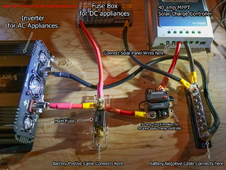You are using an out of date browser. It may not display this or other websites correctly.
You should upgrade or use an alternative browser.
You should upgrade or use an alternative browser.
Why not use circuit breaker on inverter & load?
- Thread starter zachj
- Start date
sunshine_eggo
Happy Breffast!
Fuses and breakers are sized for the wire: 1.25X
Each circuit must be protected.
Each circuit must be protected.
zachj
New Member
So seeing as my wire is big enough for both circuit breaker and fuse I can just ditch the fuse and hook it all on the breaker?
zachj
New Member
Why do you think Will decided to use both, he must have a good reason
sunshine_eggo
Happy Breffast!
Why do you think Will decided to use both, he must have a good reason
Sketch it and post. When you're building the sketch, remember that each individual circuit needs protection.
zachj
New Member
maintenance. you cant turn off a fuse.Why do you think Will decided to use both, he must have a good reason
you dont have to do anything really. but whichever safety measures you choose not to implement increase your risk for hazard ~ like welding a wrench to your system and incinerating personal property.
sunshine_eggo
Happy Breffast!
What 5awg cable can handle 180A without catching fire?
crossy
Solar Addict
What 5awg cable can handle 180A without catching fire?
Isn't 5AWG a bit small for a 1500W inverter at 12V too?
zachj
New Member
Ah right so I need a 120 Amp circuit breaker or thicker wire. So the inverter came with 5 AWG wire to connect it to a battery as it uses around 125 Amps absolute max, but running more DC loads through that would set it ablaze.What 5awg cable can handle 180A without catching fire?
zachj
New Member
Yea this is why I want to use the circuit breaker for everything instead of the fuse - so I won't have to replace a fuse but mainly so that when I disconnect/reconnect battery I don't get a spark charging up inverter capacitorsmaintenance. you cant turn off a fuse.
you dont have to do anything really. but whichever safety measures you choose not to implement increase your risk for hazard ~ like welding a wrench to your system and incinerating personal property.
zachj
New Member
It's actually 16mm squared which is actually a bit under 5AWG as well. It does get a bit warm after using anything high-draw, but never too hot to holdIsn't 5AWG a bit small for a 1500W inverter at 12V too?
crossy
Solar Addict
It's actually 16mm squared which is actually a bit under 5AWG as well. It does get a bit warm after using anything high-draw, but never too hot to hold
Yeah, we're in the metric world so I converted to 16mm2. Bangkok Cable puts their 16mm2 at 95A in free air.
It's not going to explode everywhere but if you are running constantly anywhere near 90A I'd be looking at bigger cable.
zachj
New Member
Is it safe enough to use two, three 5AWG cables in parallel instead of one large 1 or 2AWG? $160 AUD for 25 feet of 1AWG!Yeah, we're in the metric world so I converted to 16mm2. Bangkok Cable puts their 16mm2 at 95A in free air.
It's not going to explode everywhere but if you are running constantly anywhere near 90A I'd be looking at bigger cable.
crossy
Solar Addict
Is it safe enough to use two, three 5AWG cables in parallel instead of one large 1 or 2AWG? $160 AUD for 25 feet of 1AWG!
Using several smaller conductors instead of one fat one is common in the power distribution industry, we use it all the time in the rail traction-power systems (4 x 500mm2 is much easier to manage than 1 x 2000mm2) but we are talking about currents in the kA range.
It is essential that, in order to ensure proper current sharing, that all the parallel conductors are exactly the same length/resistance. In reality, at our sort of level expect 3 parallel wires to carry about 2x what one wire does, you can check how well the current is shared with your trusty DC clamp-meter.
Last edited:
mikefitz
Solar Wizard
- Joined
- May 28, 2020
- Messages
- 2,979
The connectors and internal wiring of the controller are designed for 40 amps. An internal fault would flow current only limited by a fuse or breaker in the path between controler and battery.What is the reasoning behind a 50 Amp for a 40A MPPT?
Your 180 or 120 breaker may alow a fire within the faulty controller.
Overcurrent protection is need for the cable rating and whatever current rated device is on the end of that cable.
You have a similar issue with the fuse box, it will have a maximum current rating.
zachj
New Member
Alright so you go about 10 Amps over what's rated for that equipment so that if something goes wrong, it will only go around 10 amps over and not more? If I had a 80A MPPT for example I would get a 90A circuit breaker/fuse? Assuming it's not safe to trust the device itself as Will has included this in his systemsThe connectors and internal wiring of the controller are designed for 40 amps. An internal fault would flow current only limited by a fuse or breaker in the path between controler and battery.
Your 180 or 120 breaker may alow a fire within the faulty controller.
Overcurrent protection is need for the cable rating and whatever current rated device is on the end of that cable.
You have a similar issue with the fuse box, it will have a maximum current rating.
Similar threads
- Replies
- 4
- Views
- 245
- Replies
- 35
- Views
- 587
- Replies
- 1
- Views
- 308
- Replies
- 22
- Views
- 457




